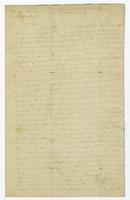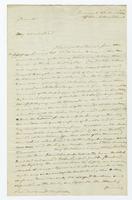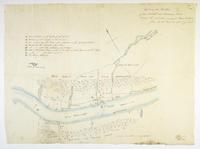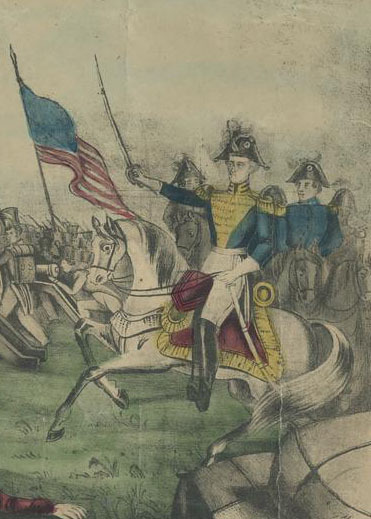New Orleans 1815
Battle of New Orleans
Though the Treaty of Ghent was signed on December 24, 1814, it still required ratification by the U. S. government. And of course, news of the treaty took weeks to reach North America and filter out to the various theaters of conflict.
In the meantime, British forces in the Gulf of Mexico moved to attack New Orleans. The city did not have particular strategic importance, but the British capture of a major port city would seize significant stores and supplies, be a distraction to the U.S. war effort, and provide a useful bargaining chip in the ongoing peace negotiations.
British and American forces fought several times in the weeks leading up to the Battle of New Orleans. During this time, Major General Andrew Jackson led the construction of a series of defensive lines protecting the city. Because the Royal Navy did not have enough vessels to move soldiers efficiently in the complicated rivers and swamps of the area, British forces were restricted in where they could approach the city.
On January 8, 1815, Major General Sir Edward Pakenham planned a four-prong attack on New Orleans. Three prongs would attack various points on Jackson’s line of defense, and the fourth prong would travel up the Mississippi River to take over the American artillery guns and turn them against the city. Naval support continued to be a problem, however, and though the British force led by Colonel William Thornton was able to take control of the artillery, they arrived too late. By the time the Royal Navy delivered Thornton’s troops, the battle was already lost.
The defeat was one of the worst suffered by the British in any war, and the losses were dramatically lopsided-- nearly 2,300 British dead to only thirteen American casualties. Almost immediately, the Battle of New Orleans entered into American national mythology as the place where plucky U. S. militia defeated the soldiers who had conquered Napoleon.
Related Items

The British have landed near New Orleans
Letter from General Andrew Jackson to Robert Hays. December 26, 1814.
General Jackson wrote: “On the 23rd instant the British effected a landing within some miles of New Orleans in force at a [?] I had directed to be well guarded and the were on the bank of the Mississippi, had come up a canal, which I had directed to be stopped, and guarded by three different orders…”

A personal account of the battle
George Robert Gleig. A narrative of the campaigns of the British army at Washington and New Orleans, under Generals Ross, Pakenham, and Lambert, in the years 1814 and 1815 : with some account of the countries visited. London : J. Murray, 1821.
Gleig was a lieutenant in the British army during the 1814 campaigns in the Chesapeake Bay and saw action in the Battle of New Orleans. His personal narrative of these conflicts are detailed; historian Robert G. Malcolmson describes them as “one of the best eyewitness depictions of the war.” His account of the initial British landing near New Orleans begins on page 272 (image 280).

Jackson remained ready
Letter from General Andrew Jackson to James Brown. January 26, 1815.
Two weeks after the Battle of New Orleans, Jackson remained vigilant. In a letter to Louisiana Senator James Brown, he wrote: “…whether they will attempt to rally their shattered forces and return to the invasion of this country, I cannot say. I shall not relax in my preparations for defence, but the government must recollect how inadequate the regular force here is to the defence of the country.”

Admiral Cochrane on the defeat
Letter from Admiral Sir Alexander Cochrane to Lord Melville. January 20, 1815.
In this eight page letter, Admiral Cochrane tries to explain the British defeat, but first he proposes a land-based strategy as a next move. He wrote: “I have just returned from the Mississippi… My public letters will explain our proceedings to the present state and I regret to say, show the necessity of our relinquishing the attempt against New Orleans from the Sea Board and to direct our efforts against Mobile from whence there is a good road to Baton Rouge which give the complete command of the Mississippi…”

A British sketch of the Battle
Letter from Admiral Alexander Cochrane to Lord Melville. January 30, 1815.
Ten days after the first letter to Lord Melville, Cochrane wrote again to forward a sketch of the Battle of New Orleans. Titled “A sketch of the position of the British and American forces during the operations against New Orleans from the 23rd December to the 8th of January,”

Announcement of the victory
Great news : defeat of the British at New Orleans. Hudson, NY : Bee-office, Feb. 8, 1815.
This broadside trumpeted: “The riflemen of Tennessee and Kentucky have mowed down like grass, the ranks of the ferocious islanders.” The text went on to marvel over the lopsided casualty numbers.

An account of the war in the south
Arsène Lacarrière Latour. Historical memoir of the war in West Florida and Louisiana in 1814-15. Philadelphia: Published by John Conrad and Co., 1816.
Major Latour was an engineer in the U.S. Army who worked on the building of fortifications in New Orleans. He dedicates this book to General Andrew Jackson.




